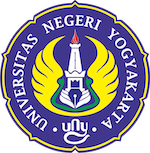Damage to roads with concrete pavement is often found in rural areas, one of the causes is the use of roads that exceed the maximum load of the road. This is due to inappropriate material selection or imperfect construction methods in implementation. Therefore, it is necessary to develop in the field of construction, especially road pavements that use concrete with the addition of mixtures from environmentally friendly materials. This attracted the attention of UNY Civil Engineering student, Ricky Surya Hutama Putra, to initiate the use of coconut fiber as a concrete additive for rural road pavements. Concrete is a construction material composed of various fine aggregates, namely sand and also coarse aggregates in the form of crushed stone, gravel, and other aggregates including water and cement. "Sometimes, additional ingredients or admixtures are added to produce concrete in special circumstances. Because concrete also has characteristics, namely low tensile and high compressive stress," said Ricky, Wednesday (26/4).
Coconut fiber (cocofiber) has the potential to be an environmentally friendly concrete admixture. With the application of this additive, concrete becomes stronger and less prone to cracking. The method of making cocofiber is by washing and drying to be made into fibers, so that coconut fiber is more durable and long lasting. The purpose of adding fiber materials to concrete mixes is to increase shrinkage resistance, resist tensile forces, and also provide an increase in flexural strength. The use of coconut fiber in concrete mixtures can increase the optimal maximum compressive strength and also the modulus of collapse of concrete has a maximum value in certain proportions.
Coir fiber is a material that has fibers with a thickness of 5 cm which is included in the outer part of the coconut. The fibers that can be extracted are 40% of the hairy fibers while a total of 60% of the mattress fibers. From a total of 1000 grams that are extracted, 70 parts of the fibers will be obtained, then 19 parts of mattress fibers and 12 parts for fur fibers. "From a technical point of view, coconut fiber has beneficial properties, which are 15-30 cm long, resistant to microorganisms, weathering, and mechanical activities such as beating or rubbing, and weighs less than other fibers," he said.
Concrete with added coconut fiber has the ability to transfer the deformation load. The fibers act to hold cracks that continue to spread in order to provide traps at the ends of the cracks so as to slow the cracks in passing through the matrix. The ultimate crack strain of the composite will increase when compared to concrete without fiber. Fiber quality is determined by the percentage of impurities, color, weight proportion between long and short fibers, and moisture content. Coconut fiber is used as a better concrete additive when the condition of coconut fiber is dry, because the tensile strength of coconut fiber in wet condition is not optimum and when tested wet coconut fiber will easily decompose during withdrawal than dry coconut fiber.





